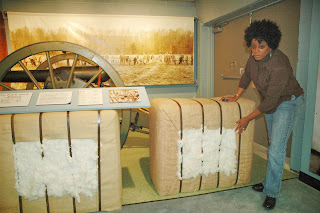 |
| Photo Credit: Shawn Escoffery |
Cotton also
known as the white gold shaped the antebellum U.S. history and the South. Far as the eyes could see, many
plantations and family farms were covered with white cotton. Cotton gins were
in full operation from the late 1700s to the 20th century. When we
think about cotton we often think about the Deep South. Many African Americans
who were field slaves did hard manual labor in the fields of plantations. They
worked in the cotton, rice, tobacco and sugarcane fields. They had to plant the
cotton, remove seeds and then bale the cotton. This was by no mean easy work
for those who worked the fields. Working from can’t see too can’t see.
By 1850 America
was producing 3,000,000 bales of cotton and industry had become the lifeline of
the South’s economic base. Eli Whitney was an American inventor best known for
inventing the cotton gin. He was born in 1765 in Westborough, Massachusetts and
died in 1825 in New Haven, Connecticut.
 |
| Sharecroppers Cotton Picking Book |
I have talked with many African Americans who picked cotton throughout
Mississippi andLouisiana. They all talked about the long sacks with the strap
that went across their shoulders and how the cotton sack would be so heavy.
They worked hard and long hours in the cotton fields. Working their fingers to
the bones as they would say. The sharecroppers and tenant farmers used day books to record the amount of cotton that was being picked for that day. Some of the books can be found in museums, family records of the plantation owners archival records that has been donated to State Archives and other repositories.
 |
| Photo Credit: Walter C. Black, Sr. |
“Yes, I picked
cotton, “ said Ms. Lula Mae. “ I was born on a plantation in Tallahatchie
County, Mississippi and I lived there all my life. I’ll never forget how we
would work hard all day long in the cotton fields. We raised a lot of beans,
corn, tomatoes, but we raised lots of cotton. I was the fastest cotton picker
—no one could beat me. Ms. Lula
Mae was around eighty- five years old when I interviewed her over three years
ago. She and all her children picked cotton in the Mississippi Delta. She talked about how hard this work was for her and the children.
 |
| Photo Credit: Walter C. Black,Sr. Cotton Museum in Memphis, TN |
In 1869 Gullet cotton gin owned and operated by Benjamin David Gullett opened
in Amite City and were located just on the edge of Amite corporate limits.
According to a reprint from a 1910 newspaper in Tangipahoa Parish, the gin was
located on the main line of the Illinois Central Railroad, having its own
Railroad and Express office, called Gullets. The company was the largest
producer of cotton gins in the south, employing over 250 people by the early 20th
Century.
My maternal great grandmother Emma Mead Harrell grew cotton in Amite, Louisiana. It wasn't until recently that I learned a man named Walter Wren, Sr. owned his own cotton gin in Amite, Louisiana. I found some crop lien records at the St. Helena Parish Courthouse that indicated my great uncle Palmer took out a lien on his property for one cotton season. Walter knew if he was to keep all of his money, he had to be in control of all his crops and equipment to maintain independent.
